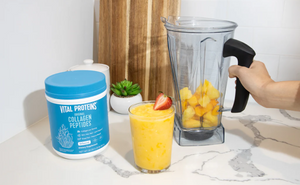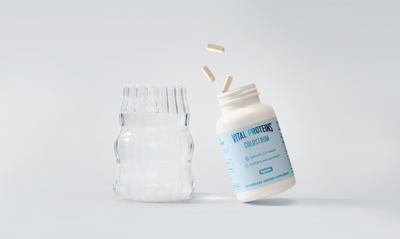Whether you're just starting out in the gym or want to get faster or stronger, you may have heard about heart rate training. While it can seem intimidating at first, once you figure out how to calculate your target heart rate zones, this style can really help you meet your training goals.
But how do you know if heart rate training is right for you? We tapped fitness experts to find out!
Vital Note: This article has been made available for informational and educational purposes only. It is not intended to be a substitute for professional medical advice, diagnosis, or treatment. Always seek the advice of your physician or another qualified health provider with any questions you may have regarding a medical condition. Your licensed healthcare professional can best provide you with the diagnosis and treatment of any medical condition and assist you as well in deciding whether a dietary supplement will be a helpful addition to your regimen.

What is heart rate training?
When you ask a runner what they are basing their training on, typically it's pace or distance. In the same sense, heart rate training is essentially what it sounds like: basing your training on what your heart rate is, or the percentage of your maximum heart rate (MHR). (So how many times per minute your heart is beating), Sandra Calva, Co-Founder and Personal Trainer at Fitness Lab, tells Lively.
Often, heart rate zones are defined as:
- Zone 1: Very light, 50 percent to 60 percent of MHR
- Zone 2: Light, 60 percent to 70 percent of MHR
- Zone 3: Moderate, 70 percent to 80 percent of MHR
- Zone 4: Hard, 80 percent to 90 percent of MHR
- Zone 5: Very hard, 90 percent to 100 percent of MHR
Who should try heart rate training?
The heart rate data you can get if you train this way is very beneficial for any athlete. It can be interpreted to workout what energy system you need to target. For example, running is predominantly an aerobic activity, so this is the main energy system you will want to develop and work on. This means the majority of your training wants to be spent at around 70 percent of your maximum heart rate and not above. This is where you will work predominantly with the aerobic energy system supplying your energy.
Heart rate training can be used for many other things. If you feel a bit under the weather, tired or not 100 percent you can use your heart rate to gauge how you are feeling. If during your warm up you notice your heart rate is far higher than it normally is, you can use that information to see that your body may be signaling you need to take it a little easy, and adapt your session accordingly, Calva explains.
You can also use the heart rate information to see progress.
"If you go for a training session and have the heart rate data from before and repeat that session but your heart rate this time is lower throughout you can see you have improved as your body isn't needing to work as hard to handle those demands," Calva says.
Is heart rate training effective?
"Training with heart rate can be incredibly effective if done right and monitored. Heart rate monitors are versatile and one of the best training tools for the money,” Head Coach of Absolute Endurance, Garret Seacat, C.S.C.S., tells Lively.
What is the best exercise to increase heart rate?
This really depends on what energy system you want to target and what adaptation you want to elicit, says Calva.
- A long, slow walk or jog for 20 minutes or more will work your aerobic system, which is 70 percent or less of your MHR and helps your ability to sustain endurance activity.
- A classic HIIT-style workout done at 70- 80 percent of your MHR will work the glycolytic system, which will help you work at a higher heart rate for longer periods of time.
- And quick, intense exercises like sprints done at 85 to 100 percent of MHR will work your ATP/PC system, which is max efforts for short amounts of time.
"There isn't really a global option for what a good training heart rate is as it depends on what the goal of your session is and what you are working toward," Cava says. "Once you know that information you can better choose what heart rate zone you need to be in."
How do heart rate monitors work?
While heart rate monitors don't measure the direct work being done (such as a power meter measuring watts during a spin class). Instead, they measure the result of the work being done.
"A great way to think of it is, a heart rate monitor has to wait for the response of the oxygen needs of your muscles to increase before it can report what is happening. You can still create accurate and effective training zones using your heart rate reserve (HRR) to find where you should be training," says Seacat.
How do you calculate heart rate training zones?
To calculate your target heart rate and training zones it will take a little math. First, subtract your age from 220 and then find your resting heart rate. (This should be done as soon as you wake up) Then, subtract your resting heart rate from the previous number.
For example, if you are 40 years old and have a resting heart rate of 80 that math will look like this: 220 - 40 = 180, then 180 - 80 = 100. To get the best possible workout for weight loss you need to get into your fat-burning range, which is considered 50 and 75 percent of your heart-rate reserve.
Using the same example as above, here's what that looks like. Take 50 percent of 100 beats per minute, which is 50 and 75 percent of 100 is 75. To find your zone you need to then add those numbers back to your resting heart rate: 50 + 80 = 130 and 75 + 80 = 155. Therefore, your best training zone to lose weight and burn fat is 130 to 155 beats per minute.
However, if you are looking to improve aerobic endurance, you'll need to train in heart rate zones higher than that needed for fat burning, explains Seacat. It ranges between 75 and 85 percent of your heart-rate reserve. So just like before get that percentage of your HHR then add it to your resting heart rate and you are ready to go!













